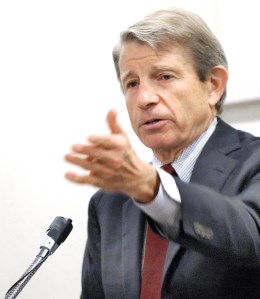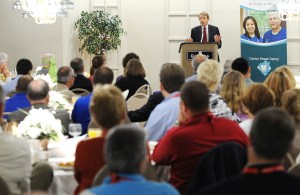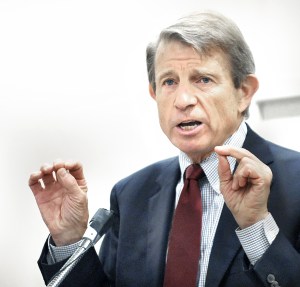LEWISTON — Maine Turnpike Authority Executive Director Peter Mills addressed a largely cordial audience Thursday during a breakfast meeting of the Androscoggin County Chamber of Commerce.
Mills spoke for about 30 minutes on the history of the turnpike and gave an elaborate accounting of why the authority has to increase revenue by $21 million in the next year. The authority is seeking increases in cash, commuter and commercial trucking tolls.
The MTA board of directors is expected to vote on toll hikes later this month, including a 50-cent bump in the cash tolls paid by drivers at the turnpike’s barrier tolls in West Gardiner and New Gloucester. Under the plan, tolls at those barriers would go from $1.25 to $1.75 and from $1.75 to $2.25, respectively.
The multiplier for commercial trucks, currently at 4 times the rate passenger vehicles pay, would go to 4.25 times, and commuters using E-ZPass transponders would see their rates go up by 10 percent, pushing their per-mile rates from 6.7 cents to 7.4 cents.
The authority has said it needs the extra revenue to maintain its payments on bond debts coming due in the next few years.
Lewiston-Auburn commuters have long complained that they pay inequitable tolls on a per-mile rate and that the community depends heavily on the turnpike as its only interstate connection, unlike communities to the north and south, which have access to toll-free Interstate 295.
Mills said a key theme that emerged from a recent round of public forums on the proposed toll increases was the demand for a more equitable tolling system and a clear message that the original toll hikes the authority was seeking were too much.
An initial proposal was to increase turnpike revenue by $26 million a year; that translated into 75-cent increases for the New Gloucester and West Gardiner toll plazas.
“The theme that emerged was, ‘What can you do to achieve something pretty close to toll equity — up and down the line?'” Mills said.
Mills’ statement that the only way Lewiston-Auburn drivers and businesses would see real toll equity would be the day the state could put tolls on I-295 drew a round of applause.
Under federal law, Mills said, it could be possible to add tolls to I-295, but only if there was a need to expand the highway. Based on current traffic volume, that didn’t seem a likely scenario for at least the next 10 to 15 years, he said.
He agreed with L-A commuters who are angered that it costs $1 more to come back from Portland on the turnpike than it costs to go there.
“I’ve got to agree; it’s nuts to say it costs a dollar more to get home than it does to go to Portland,” Mills said. He said that inequity was a result of keeping $1 side-toll exits in the Portland area while eliminating tolls at other exits along the turnpike’s 109 miles.
“Yes, it’s not equitable, and at some level it doesn’t even make sense,” Mills said. “But it makes sense in the scheme of things and it makes sense from the turnpike’s perspective when you understand the decisions that were made to abandon so many cash-toll facilities and reduce the cost of running the turnpike.”
Mills pitched the idea that commuters had a role to play in keeping the turnpike’s costs down, and that by converting to the turnpike’s electronic tolling system, the E-ZPass, both commuters and the authority would save money.
One audience member suggested the $10 cost of the E-ZPass transponder be added to the cost of vehicle registrations in Maine as a way to push Maine drivers to electronic tolling systems.
Mills said that would be one way to encourage the use of the transponders, but it would require an act of the Legislature.
The toll increases, which the MTA board is expected to ratify with a vote when it meets in Portland on Aug. 16, represent a real compromise, Mills said, and an effort by the MTA staff to find ways to reduce the total amount of revenue needed.
They were able to do that largely by delaying the borrowing of new funds for improvement and expansion projects that were not going to move forward this year because of land acquisition and environmental permitting delays.
One includes an expansion and redesign of Lewiston’s Exit 80. That project is set for completion in 2017, Mills said.
The authority’s board voted 5-2 on Aug. 2 to tentatively approve the hikes. Androscoggin County representative Robert Stone was opposed to the plan.
He advocated a plan that would have pushed drivers more quickly to an all-electronic tolling system and would have created a per-mile toll rate that was the same no matter where you started your trip.



Comments are no longer available on this story